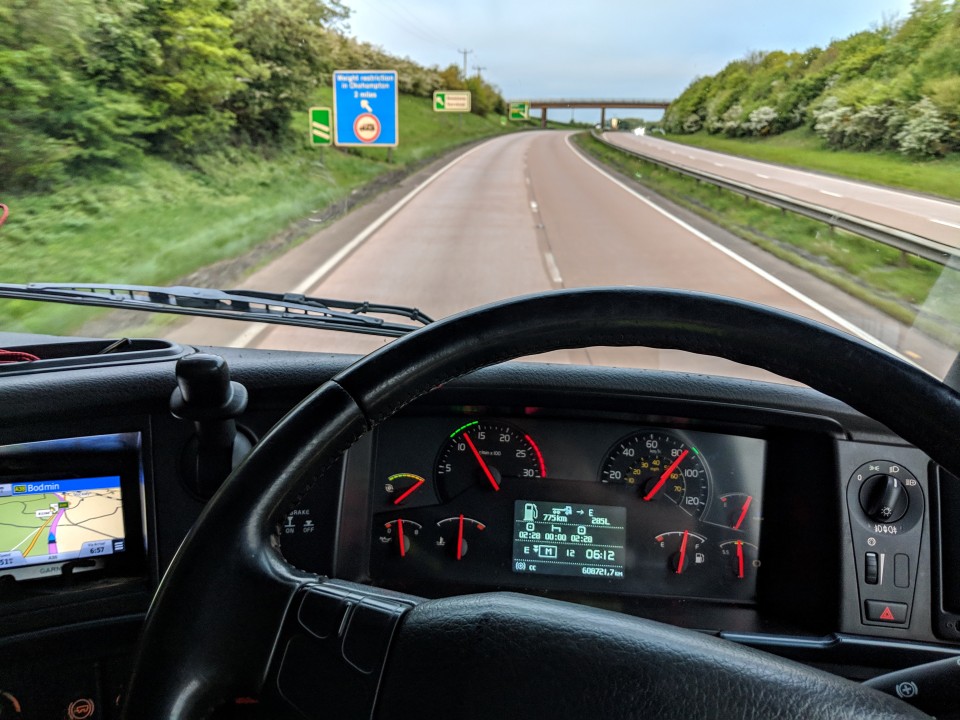
Susie Jones
Las normas del tacógrafo, más fáciles
Creado: 01/08/2024
•
Actualizado: 08/08/2024
El mundo de las normas del tacógrafo puede ser un lugar confuso para el camionero más experimentado. Y mucho más para cualquiera que se incorpore por primera vez al sector. Nuestro objetivo es aclarar parte de esa confusión.
¿Qué es un tacógrafo y por qué los tenemos?
Según el diccionario, un tacógrafo es "un dispositivo que se coloca en vehículos como camiones y autocares para registrar información como la velocidad a la que va el vehículo, la distancia que recorre y el número de descansos que hace el conductor."
La finalidad del tacógrafo es evitar la fatiga del conductor y garantizar que conductores y empresarios cumplen las normas. La organización benéfica de seguridad vial Brake informó de que "cuatro de cada diez accidentes relacionados con el cansancio implican a alguien que conduce un vehículo comercial". Por lo tanto, las normas sobre tacógrafos desempeñan un papel vital en el objetivo de reducir esta cifra.
¿Cuándo se necesita un tacógrafo?
Necesitas instalar un tacógrafo si el peso bruto de tu vehículo supera las tres toneladas y media. Es importante recordar que esto incluye arrastrar un remolque. Hay algunas excepciones a esta regla:
Si sólo conduces por vías públicas
Si el vehículo es conducido por fuerzas armadas, policía o bomberos
Si es una flota comercial y utiliza vehículos con un peso máximo de siete toneladas y media, y su trayecto es inferior a 100 km desde su base de operaciones.
Si transporta mercancías y su vehículo es eléctrico
Si transporta equipos o maquinaria para uso del conductor, y la conducción de este vehículo no es su trabajo principal.
¿Cuáles son los distintos tipos de tacógrafos?
Existen tres tipos diferentes de tacógrafos:
Analógicos: Se hicieron obligatorios en Europa en 1986. Los tacógrafos analógicos utilizan hojas de papel encerado para registrar los datos del conductor. Los conductores introducen manualmente los datos y los introducen en un tacógrafo.
Digitales: Se introdujeron en 2006. Los utilizan más de un millón de empresas de transporte y más de seis millones de conductores profesionales. Los tacógrafos digitales registran los datos del conductor en un dispositivo de almacenamiento interno y en la tarjeta del conductor.
Inteligentes: A partir de junio de 2019, la Unión Europea obliga a las empresas a utilizar tacógrafos inteligentes. Estos registran automáticamente la ubicación del vehículo al principio y al final de cada trayecto. También proporcionan actualizaciones cada tres horas
¿Qué significa cada símbolo del tacógrafo?
Eche un vistazo a nuestro vídeo en el que se explica cada símbolo del tacógrafo
Reglas de seguridad
Por la seguridad del camionero y de todos los que circulan por la carretera, deben respetarse las normas de seguridad. Hemos desglosado los puntos clave.
Tiempo de conducción:
- No puede ser superior a cuatro horas y media antes de un descanso
Pausas:
- Deben ser de al menos 45 minutos a menos que un conductor tome un período de descanso
Periodo de descanso:
- Durante un periodo de descanso no se puede conducir, ni realizar ningún otro trabajo.
Dividir las pausas:
Una pausa completa de 45 minutos puede dividirse en una pausa de 15 minutos seguida de otra de 30 minutos.
Las pausas de descanso deben distribuirse a lo largo de las cuatro horas y media de conducción.
Según las normas de la UE, si las pausas se dividen, la segunda pausa debe ser de al menos 30 minutos.

Límite diario de conducción
El límite diario de conducción se refiere al tiempo máximo de conducción en un día. Nueve horas es el máximo, pero puede aumentarse a diez. Sin embargo, esto no puede hacerse más de dos veces en una semana fija. El tiempo diario de conducción puede definirse como:
El tiempo total de conducción acumulado entre el final de un período de descanso diario y el comienzo del siguiente período de descanso diario.
El tiempo total de conducción acumulado entre un período de descanso diario y un período de descanso semanal. .
Límite de conducción semanal y bisemanal
Los conductores deben asegurarse de que no superan los límites máximos de conducción semanal y bisemanal.
El límite máximo de conducción semanal es de 56 horas (se aplica a una semana fija)
Una semana fija comienza a las 00.00 y termina a las 24.00 del domingo siguiente.
El límite de conducción quincenal es de 90 horas.
Descanso diario
Además, debe tomarse un descanso diario.
El conductor debe descansar 11 horas seguidas. Esto puede reducirse a nueve
Esta reducción sólo puede producirse hasta tres veces entre periodos de descanso semanales
El periodo de descanso debe completarse en las 24 horas siguientes al final del último periodo de descanso diario o semanal.
El descanso diario puede tomarse en el vehículo; sin embargo, se requieren instalaciones adecuadas para dormir. Si faltan estas instalaciones, el conductor debe buscar alojamiento. Consulte nuestra página lugares para saber qué paradas de camiones ofrecen este servicio.
Descanso semanal
Los períodos de descanso semanal deben tomarse a más tardar al final de seis períodos consecutivos de 24 horas a partir del final del último descanso semanal.
Los conductores deben descansar al menos 45 horas
Pueden tomarse un descanso semanal reducido de al menos 24 horas
El descanso semanal reducido debe compensarse en un bloque, y al menos nueve horas antes del final de la tercera semana.
Aunque puede tomarse un descanso reducido, conviene tener en cuenta que en dos semanas consecutivas en las que se haya tomado un descanso reducido, uno debe ser de 45 horas.

Tripulación múltiple
Algunos conductores pueden llevar a bordo a otro conductor. Las ventajas incluyen una mayor productividad, un mayor kilometraje recorrido y más tiempo de conducción.
Ambos conductores deben tomar nueve horas de descanso diario
Este descanso diario debe tomarse en un plazo de 30 horas en lugar de 24.
La primera hora de conducción múltiple no requiere otro conductor. Después de una hora se convierte en obligatorio.
Travesías en ferry o tren
Como se ha indicado anteriormente, el periodo de descanso diario normal de un conductor debe ser de 11 horas ininterrumpidas, aunque existen algunas excepciones a esta norma. Siempre que el vehículo vaya acompañado por el conductor, los periodos de descanso diario pueden interrumpirse dos veces, pero no deben superar una hora en total. Por ejemplo, embarque y desembarque de transbordadores y trenes.
Si el período de descanso diario normal se interrumpe de esta manera, el período de descanso acumulado debe ser de al menos 11 horas o de 12 si se divide.
¿Qué es la norma del tacógrafo de un minuto?
La regla del minuto entró en vigor en octubre de 2011. Hace referencia a la antigua legislación que establecía que un minuto con al menos cinco segundos de conducción debía registrarse como tiempo de conducción. Sin embargo, la UE modificó esta legislación para que la actividad continua más larga realizada en un minuto se registre en relación con esa actividad específica.
¿Qué pasaría si no cumpliera las normas del tacógrafo?
El incumplimiento de las normas del tacógrafo puede acarrear multas y, en ocasiones, penas de prisión. En general, la sanción depende de la gravedad de la infracción. La mayoría de las infracciones del tacógrafo se sancionan con multas fijas. Los conductores tienen hasta 28 días para considerar las sanciones fijas.
En el Reino Unido existen dos tipos de multas y sanciones.
Multas de nivel cuatro: Tienen un límite de 2.500 £; este límite es para cada multa de tacógrafo. Sin embargo, los casos con múltiples infracciones de nivel cuatro podrían enfrentarse a una multa máxima por infracción.
Multas de nivel cinco: Tienen un límite máximo de 5.000 libras esterlinas, aunque, al igual que ocurre con las multas de nivel cuatro, los casos de infracciones múltiples podrían enfrentarse a la multa máxima.
Las normas del tacógrafo pueden ser difíciles de entender. Sin embargo, no cumplirlas puede acarrear problemas de seguridad y posibles multas. Comprendiendo y respetando las normas, las flotas y los conductores pueden utilizar sus vehículos de forma segura y legal. Es fundamental tener en cuenta que las normas y reglamentos sobre tacógrafos pueden variar de un país a otro.



